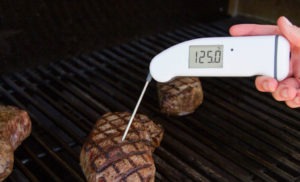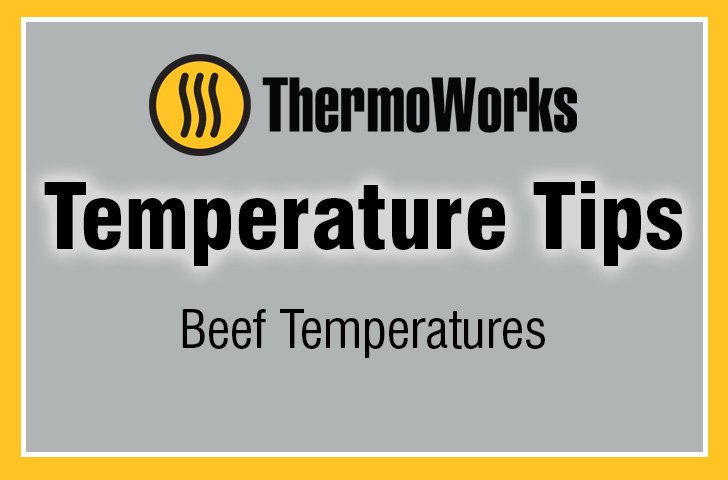Beef Temperatures
For consistent results, while cooking beef, it is important to know your target doneness temperatures. We’re partial to medium rare ourselves for its flavor and tenderness, but whether you like your beef rare or on the well-done side, use a fast and accurate instant-read thermometer, like the Thermapen® ONE, to make sure you get just the doneness you prefer. (Learn more about what thermometer to use for beef.) Keep in mind, ground beef should always be cooked to at least 160°F for food safety reasons. The following temperature chart is for steaks, prime rib and other roasts, and other whole muscle cuts of beef.
Beef Temperature Chart
| Beef Doneness | Final Done Temperature |
|---|---|
| Rare | 120-130ºF |
| Medium Rare | 130-135ºF |
| Medium | 135-140ºF |
| Medium Well | 145-155ºF |
| Well Done | 155ºF and up |
It is also important to note, that these temperatures are the final doneness temperatures. Beef should be pulled from heat 3 to 10ºF lower than these temperatures (depending upon the size of the cut and the intensity of the cooking environment) to account for carry-over cooking while the beef rests before carving and serving.
*These beef temperatures come from our Chef Recommended, ThermoWorks Approved temperature chart. Check it out to learn more about temperatures you should be aiming for.
Additional Temperature Tips
- Achieve those perfect Turkey temps for your Thanksgiving feast
More on Beef Temperatures and Tools
 And the Science Behind It |
 Own a Thermapen |
|---|



I really appreciate the data you provide, its very helpful when using my MK4 or my Smoke thermometer (love them both). What would be really helpful for an amateur cook like myself is a chart to help calculate pull temp and stand time for carryover cooking with beef, pork and poltry. It seams to me that the time is affected by the mass (thickness/weight) of the meat. There must be a way to chart this for quick reference.
Galen,
This is a question that has come up before. However, I think an unsatisfactory answer is all I can give. It is true that charts abound for finished temperatures (including ours), but I think you probably won’t ever find a pull chart, not even from us.
The reason we (and, I assume, others) don’t publish such a thing is pull temps are surprisingly variable. The higher the heat, the more carryover there will be because the thermal gradients will be wider. 225°F will carryover less than 300°F. So the pull temperature for any given target temp must be viewed by way of the heat at which the food is being cooked.
Another reason is size. Larger items experience more carryover than smaller items. This may seem counterintuitive, but if you think of the thermal mass of a whole prime rib vs. the thermal mass of a hamburger, you can see that there is a larger heat reservoir in the roast that can do carryover cooking.
Add to these the fact that heat transfer is proportional to the square of thickness, and you can see that the chart we’d have to make would probably need to be a rather complex 3-dimensional matrix. I can’t speak for other sources, but I think our dedication to precision here at ThermoWorks prevents us from making a chart that would be anything short of correct, and so we make none at all.
In general, know that low heat carries over less, so your pull temps will be 2-5 degrees below your target. The higher the cooking temp, the greater the pull gap, up to 10° or maybe even 15°F. A 450°F oven-roasted chicken could be pulled 10° below target without much worry, as long as it has time to rest.
As Harold McGee says “The extent of after heating depends on the meat’s weight, shape, and center temperature, and the cooking temperature, and can range from a negligible few degrees in a thin cut to 20°F in a large roast”
I’m sorry I can’t provide you with such a chart, but I hope that this understanding will help soften the blow.
Cook luck with your cooking, and thanks for writing in!
Thank you for providing the reasoning behind when to pull a piece of meat.
It makes sense when you think about it.
Happy New Year 2023